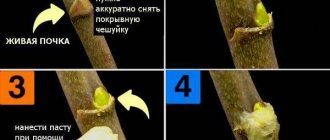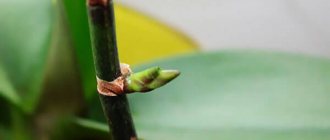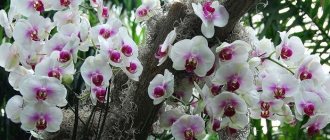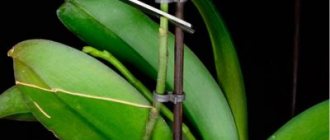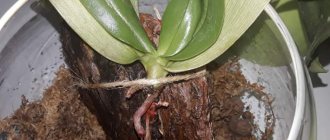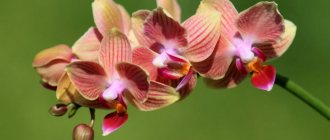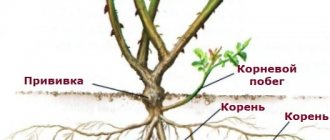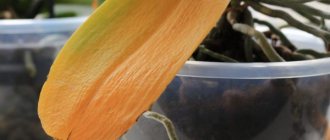general information
An orchid's peduncle is a shoot on which flowers form . There can be more than 50 buds on one peduncle! But this is for an adult and large orchid. The peduncle looks like a long and flexible stem, on which subsequently, after it has grown to a certain length, orchid buds will begin to bloom. Some gardeners use the term “peduncle” in a narrower sense and understand it as the area of the stem part of the plant on which the flowers are located.
ATTENTION : Peduncles can grow in the most bizarre ways, both straight and bending in all directions. Sometimes they bend like a pig's tail, twisting into rings.
The main rule is that the peduncle always grows from the growing point. Read more about the appearance and development of the peduncle here.
Changing containment conditions when the arrow appears
When a flower branch appears, the contents of the plant change slightly. First of all, it is placed closer to the light source , but not in direct sun. If it is autumn-winter time, then illumination with special lamps for plants may be required.
Watering during shoot growth remains at the same level , but we must remember that fertilizing is applied before the first bud begins to form.
At the moment the shoot grows, fertilizers will no longer affect the number of buds. The number of flowers is influenced by the care the plant receives before the flower shoot is thrown out.
Why is it important to determine what new shoots a plant has?
Whatever happens to an orchid is always a joy for a gardener who loves his plant. A new root, baby or peduncle that promises lush flowering is equally good. But it is still worth distinguishing the peduncle from other parts .
This way you will understand that the plant needs to be cared for more carefully. After all, during the flowering period, an orchid requires special attention and periodic feeding. The watering schedule also changes.- It is not always a good idea to let a plant bloom. If it is not healthy, or has just undergone a difficult transplant (for example, due to rotten roots), the best solution would be to cut off the peduncle to give it strength to grow directly.
- No one canceled simple interest. And an orchid, as you know, is a leisurely flower, and it will take a long time to grow an incomprehensible shoot.
What does he look like?
Throughout its life cycle, the peduncle changes greatly. It can be of two types.
New
It usually grows from the leaf axil - the place where the leaf comes close to the stem. It breaks through the leaf. The peduncle is usually flat in shape, but has a pointed tip that has a stepped shape . It is light green or rich green in color, growing upward or sideways, heading towards the sun.
IMPORTANT : You can immediately see the scales on the peduncle. From the beginning of the growth of the peduncle to the opening of the first buds on it, it usually takes about a couple of months, so be patient.
Old
Gradually, the hatched peduncle will grow, turning into a long flexible stem, juicy and green. Then the buds will bloom on it. Orchid flower stalks are very fragile and easy to break . So it is better to tie the peduncle as it grows.
When the orchid fades, the peduncle will begin to change: it will change color to yellow or brown. Sometimes the color may even change to red or bright purple. After this, the old peduncle dries out and falls off. But it’s better not to let it get to this point, and cut off the peduncle immediately after the last flower has withered - this way you will save the plant’s strength.
But sometimes it is difficult to understand whether the flowering period has already ended . Pay attention to the tip of the peduncle. While it is green, this means that it is growing, it can increase in size and produce new buds. But if the tip turns yellow, blackened or dried out, flowering has come to an end.
Whether or not to trim the peduncle can be decided individually. The fact is that the old peduncle can bloom again or form a baby. On the other hand, old flower stalks inhibit the development of new ones and generally weaken the plant. We discussed the issue of caring for a faded orchid in more detail here.
How to distinguish from the root?
A recently hatched peduncle can easily be confused with a root or baby. Focus on these differences:
Peduncle:- Appears strictly from the neck of one of the freshly formed leaves.
- The tip is sharp and has a complex, stepped, cone-like shape.
- The shape of the tip is somewhat reminiscent of a closed beak.
- The shape of the peduncle itself is something flattened, rather flat.
- It stretches upward, less often sideways. The peduncle will fall down later, under the weight of the formed buds, if it is not tied up in time.
- Root:
- It often grows outside rather than in the leaf axils. It can grow from anywhere on the orchid neck, including from the middle of the leaf.
- The tip is bright, and then there is a light velamen.
- The shape of the tip is round, smooth, without scales.
- The shape of the bud is evenly rounded and cone-shaped.
- It can grow in any direction: up, sideways, but more often it tends downwards.
Watch a video about the difference between a peduncle and an orchid root:
How is a peduncle different from a baby?
What does the baby look like:
- It grows in the place of the peduncle, next to the central vein of the leaf.
- The shape of the tip is similar to an open beak.
- Pointed upward.
It is almost impossible to distinguish a peduncle from a baby . You need to wait until the process increases to at least 3 cm, then it will be possible to understand something from the shape of the tip. The ability to instantly recognize what exactly your orchid is growing comes with experience.
Watch a video about the difference between a baby and an orchid peduncle:
Photo
The presented photos clearly demonstrate the modification of the orchid peduncle throughout its life, as well as the difference between the flowering shoot and the baby and roots.
How to care?
After releasing a peduncle, the orchid can bloom for up to a year, gradually increasing it and opening bud after bud. In another scenario, many flowers will open on the orchid at the same time, which will soon wither.
You can prolong flowering by properly caring for an orchid with a peduncle.:
Do not allow the peduncle to remain in a draft. Both cold and warm air flow are equally destructive for him, so keep him away from the radiator and air conditioner. An orchid that has stood in a draft for a day can lose all its flowers.- Once you have determined that it is a peduncle and not a baby or a root, forget about replanting for a while. While flowering is in progress, you cannot touch the orchid. This is especially true for phalaenopsis, which is capricious in terms of transplantation.
- Secure the peduncle to a special holder, or tie it up in some way.
Of course, in nature no one ties up the flower stalks, and they fall down in a spectacular cascade. But at home, a loose peduncle can be easily damaged. Especially if you have pets who are always ready to try something new. TIP : A reliable fastening can be a plastic or wooden support, to which the peduncle is attached with a special clamp. You can simply tie it with thin satin ribbons or strong threads - it’s even more aesthetically pleasing. Do not tighten the thread too tightly so that it does not cut the succulent peduncle. - Provide the flower stalk with sufficient lighting. If there is not enough natural light, add additional lighting. Otherwise, it will reach towards the light, grow behind it, and you will get a spiral instead of an even arrow. In addition, only with full lighting will the peduncle develop normally: the more light, the faster it grows.
- It is necessary to water the orchid during the growth of the peduncle according to the same scheme. But with the beginning of flowering, reduce watering.
- If you fed the orchid, then continue feeding until the first flower forms.
- If after flowering the peduncle begins to dry out quickly, cut it off with sharp scissors. You need to leave a small “stump”. Sprinkle the cut area for disinfection with crushed charcoal or ground cinnamon. The remaining stump will be hollow inside. If water begins to stagnate in it, this will lead to rotting of the trunk. It is better to immediately seal the hole hermetically, for example with beeswax.
- If the peduncle remains green, do not rush to cut it off. Or trim the peduncle just above the third node - this will stimulate re-blooming. But it is better not to use this advice if the plant is still young - it does not have enough strength for a baby or a new flowering.
Watch a video about caring for an orchid with a peduncle:
Difficulties in growing
Causes of yellowing
The yellowness of the peduncle means it is dying and the orchid is unable to bloom. Although the peduncle can simply freeze in development and still remain green. Rushing to prune means hopelessly ruining the flowering. He may yet awaken. If the color of the peduncle has changed, you need to analyze why:
- Lack of sun
- The flower does not have enough water or there are difficulties in the functioning of the root system
- The appearance of pests
- The orchid is sick, she has a weak immune system and does not have the strength to bloom
In this case, in order to save the flowering of the orchid, it is worth changing the conditions of its maintenance or treating it with drugs.
Why does it dry out?
The peduncle can dry out in bright sunlight due to a burn or when the plant gets a cold as a result of being left in the cold for a long time.
What to do if it breaks
In this case, gluing the peduncle with tape is not an option. The infection can get into the flower, and the orchid will simply die. The solution in this case is to cut the arrow to the nearest bud and cauterize the cut site with activated carbon or cinnamon.
Grew up short
Another type of underdevelopment of the peduncle. The cause of the problem lies in the lack of sunlight and nutrient deficiency due to improper maintenance conditions or plant disease.
